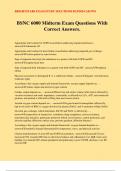BRIGHTSTARS EXAM STUDY SOLUTIONS 8/15/2024 2:05 PM
BSNC 6000 Midterm Exam Questions With
Correct Answers.
Appropriate intervention for COPD exacerbation addressing impaired perfusion -
answer✔✔Administer O2
Appropriate intervention for heart failure exacerbation addressing impaired gas exchange -
answer✔✔Position patient in semi-fowlers
Sign of impaired electrolyte the imbalance in a patient with both COPD and HF -
answer✔✔irregular heart beat
Sign of impaired fluid imbalance in a patient with both COPD and HF - answer✔✔Peripheral
edema
Physical assessment to distinguish R vs L sided heart failure - answer✔✔jugular vein distension
(indicates right)
According to the oxygen supply and demand framework, oxygen supply depends on... -
answer✔✔Cardiac output and arterial oxygen content
Cardiac output depends on... - answer✔✔Heart rate and stroke volume (after load is affected by
vascular resistance and aortic impedance, contractility is affected by Ca2+, ATP, and contractile
proteins, and preload is affected by filling time and venous return)
Arterial oxygen content depends on... - answer✔✔Oxygen bound to hemoglobin (affected by
hgb levels and # of RBCs), oxygen dissolved in plasma (PaO2), and $ saturation of Hgb (SaO2)
Alveolar gas exchange, which determines PaCO2 and PaO2, is affected by... -
answer✔✔composition of inspired air, ventilation (lung compliance, airway resistance,
neuromuscular function), pulmonary perfusion (blood vessel latency, central perfusion), and
alveolar capillary diffusion (surface area, pressure gradient, diffusion distance)
According to the oxygen supply and demand framework, oxygen demand depends on... -
answer✔✔metabolic demand (determined by temperature, stress, and physical activity)
Clinical manifestations of acute HF and COPD exacerbation - answer✔✔decreased O2 sats,
increased CO2, irregular HR (due to electrolyte balance and salbutamol), low HgB, lactic acid
buildup, low diastolic BP, edema (peripheral and pulmonary), poor CWMS, dizziness, low EF,
increase RR
,BRIGHTSTARS EXAM STUDY SOLUTIONS 8/15/2024 2:05 PM
Pharmacological management of clients experiencing exacerbation of COPD and HF -
answer✔✔Salbutamol: bronchodilator, used as long term agent in COPD
Atrovent: controlling symptoms of COPD by relaxing airway muscles
Steroids (anti-inflammatories): help reduce inflammation in lungs, however can increase fluid
retention in HF
Furosemide: prevent fluid retention, helps peripheral and pulmonary edema (may cause
dehydration or electrolyte imbalance)
Definition of delirium - answer✔✔Acute confusional state
Risks of delirium - answer✔✔Infection, multiple medications, change in environment,
dehydration, surgery, injury, constipation, pain
Outcomes of delirium + treatment - answer✔✔changes in mood, alertness, agitation, drowsiness,
hallucinations, delusions, disturbed sleep, disorganized thinking. Treated by addressing cause,
occasionally by antipsychotics (haloperidol)
Definition of dementia - answer✔✔a general term for the impaired ability to remember, think, or
make decisions that interferes with doing everyday activities
Outcomes of dementia - answer✔✔decline in communication, learning, remembering, and
problem solving
Treatment of dementia - answer✔✔anticholinesterase inhibitors to slow the progression.
Symptomatic treatment with environmental & staff approaches. Maintain and enhance remaining
abilities.
Definition of depression - answer✔✔Mood disorder that causes persistent feelings of sadness or
loss of interest
Outcomes of depression - answer✔✔selective memory, highlighting negativity, feeling of
physical illness, withdrawing, often answering questions with "I dont know"
Treatment of depression - answer✔✔antidepressants, ECT, cognitive therapy, assist person to
improve confidence and self-esteem through conversation and activity
Alcohol withdrawal timeline - answer✔✔stage 1 - 8 hours: anxiety, insomnia, nausea, abdominal
pain
, BRIGHTSTARS EXAM STUDY SOLUTIONS 8/15/2024 2:05 PM
stage 2 - 1-3 days: high blood pressure, increased body temp
stage 3 - 1 week, up to weeks if not treated: hallucinations, fever, seizures, agitation
Characteristics of ECG wave - answer✔✔ECG waves measure electrical activity, not
contractions or pumping.
P: atrial depolarization, SA node firing
PR segment: atrial systole, "Pause": atrial construction needs to finish prior to ventricular
contraction
QRS complex: ventricular depolarization, AV node firing
ST segment: ventricular systole
T: repolarization, ("undo-ing") electrical firing
What causes upward and downward deflections - answer✔✔electrical activity is going in the
same direction as lead, electrical activity away from a lead causes a downward deflection
(depolarization and repolarization deflections occur in opposite directions.)
What causes an increase in amplitude (on ECG) - answer✔✔synchronicity, mass (ex. Ventricle
vs. atria)
What does a peaked T wave indicate - answer✔✔hyperkalemia
What is heart rate controlled by? - answer✔✔the autonomic nervous system → extrinsic factors
impact HR through the sympathetic (increases HR) and parasympathetic (decreases HR)
Intrinsic rates - answer✔✔SA node is 60-100, AV node is 40-60, Purkinje fibers are 20-40
Sympathetic receptors - answer✔✔Epinephrine and norepinephrine
alpha 1: arterial vasoconstriction
beta 1: increase HR and contractility
beta 2: bronchodilation
4 causes of cardiac arrhythmias - answer✔✔abnormal rhythmicity of pacemaker, pacemaker not
from sinus node, abnormal pathways of impulse transmission through heart, electrical blocks at
different points of pacemaker path




